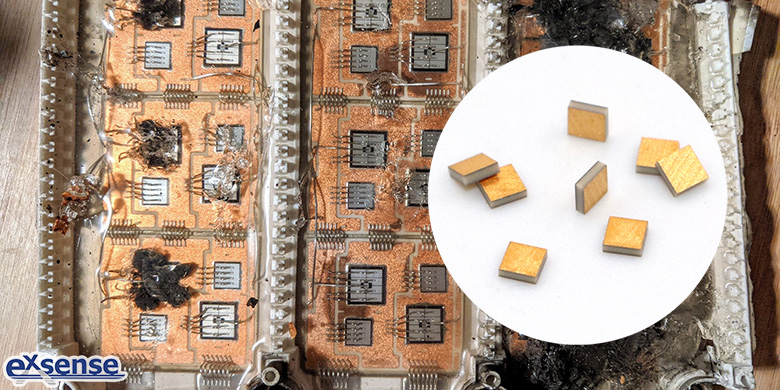
Overcurrent of IGBT generally refers to the load overload (e.g. motor locked-rotor) caused by some reason, or it may be caused by the current divergence and oscillation of software control problems. The short circuit generally refers to the bridge arm straight-through, or the busbar voltage through the unloaded circuit of IGBT. The protection method of overcurrent and short circuit is also different, overcurrent protection usually uses output current sensor as the test components, enforce the protection on the control panel by hardware or software, and short circuit protection can only be detected through hardware testing, generally integrated into the IGBT driver circuit, protection is implemented by detecting desaturation behavior of IGBT. EXSENSE Electronics takes industrial motor driven inverter as an example to introduce common short-circuit faults:
First, bridge arm straight-through
When two IGBTs on an arm are switched on at the same time, the bridge arm will be straight-through. This may be due to electromagnetic interference or controller failure, or it may be due to one of the IGBTs on the arm fails and the normal IGBT keeps the switch active.
Second, inter-phase short circuit
It may be caused by insulation breakdown between motor windings due to performance reduction, high temperature or over-voltage events, or may also be caused by insulation damage of transmission cable.
Third, grounded short circuit
It may be also caused by insulation breakdown between motor windings due to performance reduction, high temperature or over-voltage events, or may also be caused by insulation damage of transmission cable.
The above three faults can be called short circuit faults, but the impedance of the short circuit is different. If the inverter output cable is long and short circuit occurs at the end of the cable, the short circuit impedance is relatively large, this short circuit and overcurrent may not be too different, which can also be short circuit protection through the output current sensor. It is important to note that IGBT has a relatively small probability of short-circuit failure of bridge arm straight-through. Therefore, in some low cost applications, IGBT driver circuits do not have integrated short circuit protection, only overcurrent protection. If a short circuit occurs on the load side, whether the device can be saved mainly depends on the size of the impedance of the short circuit and the response speed of the current sensor.
Through the above analysis, we should know the difference between overcurrent and short circuit. Below, from the IGBT perspective to analyze several common short-circuit fault types:
First, short-circuit behavior in opened transient of IGBT
Short circuit fault caused by IGBT opening (the process of gate voltage from negative voltage to positive voltage), that is, before IGBT opening, there is no short circuit fault in the system.
Second, short-circuit behavior in on-state process of IGBT
A sudden increase in device current due to external causes when IGBT is on (the gate is open with positive pressure) and the positive guide is on current.
Third, short-circuit behavior during on-state process
The sudden increase of device current caused by external causes when IGBT is on (the gate is open with positive pressure) and the internal fly-wheel diode is on.
The resistance value of NTC thermistor chip for IGBT produced by EXSENSE Electronics Technology Co., Ltd. decreases with the increase of temperature. Using this characteristic, NTC thermistor chip is able to play the role of temperature monitoring and temperature controlling in IGBT module.







